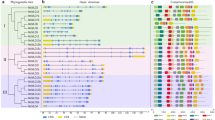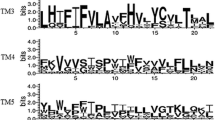Abstract
Mulberry is a fast growing economically important tree for sericulture industry and contains compounds for preventing and treating several diseases and ailments. The quality and quantity of mulberry leaf available to produce silk fibre and for medicinal purpose is greatly affected by number of foliar diseases, out of which powdery mildew is the major one. Imparting genetic resistance becomes an important approach in disease management in mulberry as spraying of fungicides has harmful effects on silkworm growth and development. Deployment of non-functional susceptible genes such as Mildew resistance Locus O (MLO) against powdery mildew in few crops stimulated to identify and characterize MLO genes in mulberry. In this study, genome wide analysis identified 16 MLO genes in Morus notabilis. Phylogenetic analysis found that MnMLO2, MnMLO6A, MnMLO6B, MnMLO12A and MnMLO12B clustered with functionally characterized MLOs associated with powdery mildew susceptibility in dicot species. Gene expression analysis indicated increased transcript abundance of MnMLO2, MnMLO6A, and MnMLO12A in response to powdery mildew infection. Further, conserved motifs exclusive to functionally characterized MLOs were identified in MnMLO1C, MnMLO2 and MnMLO6A proteins. Combined analysis of the phylogenetic relationship, conserved motif analysis and gene expression in response to infection identified MnMLO2 and MnMLO6A as potential candidate genes involved in powdery mildew susceptibility in mulberry. Identification and deployment of natural and induced mutations in the candidate genes can be useful for mulberry breeding programs to develop powdery mildew resistant varieties.





Similar content being viewed by others
References
Rodrigues EL, Marcelino G, Silva GT, Figueiredo PS, Garcez WS, Corsino J, Guimarães de RD, Freitas de KD (2019) Nutraceutical and medicinal potential of the Morus species in metabolic dysfunctions. Int J Mol Sci 20(2):301. https://doi.org/10.3390/ijms20020301
Gupta VP (2001) Diseases of mulberry and their management. In: Srivastava MK (ed) Plant pathology. Pointer Publishers, Jaipur, pp 130–164
Pavan S, Jacobsen E, Visser RGF, Bai Y (2010) Loss of susceptibility as a novel breeding strategy for durable and broad-spectrum resistance. Mol Breed 25:1–12. https://doi.org/10.1007/s11032-009-9323-6
Acevedo-Garcia J, Kusch S, Panstruga R (2014) Magical mystery tour: MLO proteins in plant immunity and beyond. New Phytol 204:273–281. https://doi.org/10.1111/NPH.12889@10.1002
Consonni C, Humphry ME, Hartmann HA, Livaja M, Durner J, Westphal L, Vogel J, Lipka V, Kemmerling B, Schulze-Lefert P, Somerville SC, Panstruga R (2006) Conserved requirement for a plant host cell protein in powdery mildew pathogenesis. Nat Genet 38:716–720. https://doi.org/10.1038/ng1806
Bai Y, Pavan S, Zheng Z, Zappel NF, Reinstädler A, Lotti C, De Giovanni C, Ricciardi L, Lindhout P, Visser R, Theres K, Panstruga R (2008) Naturally occurring broad-spectrum powdery mildew resistance in a Central American tomato accession is caused by loss of Mlo function. Mol Plant-Microbe Interact 21:30–39. https://doi.org/10.1094/MPMI-21-1-0030
Feechan A, Jermakow AM, Dry IB (2009) Grapevine MLO candidates required for powdery mildew pathogenicity? Plant Signal Behav 4:522–523. https://doi.org/10.4161/psb.4.6.8575
Zhou SJ, Jing Z, Shi JL (2013) Genome-wide identification, characterization, and expression analysis of the MLO gene family in Cucumis sativus. Genet Mol Res 12:6565–6578. https://doi.org/10.4238/2013.December.11.8
Pessina S, Pavan S, Catalano D, Gallotta A, Visser RGF, Bai Y, Malnoy M, Schouten HJ (2014) Characterization of the MLO gene family in Rosaceae and gene expression analysis in Malus domestica. BMC Genom 15:618. https://doi.org/10.1186/1471-2164-15-618
Liu Q, Zhu H (2008) Molecular evolution of the MLO gene family in Oryza sativa and their functional divergence. Gene 409:1–10. https://doi.org/10.1016/j.gene.2007.10.031
Konishi S, Sasakuma T, Sasanuma T (2010) Identification of novel Mlo family members in wheat and their genetic characterization. Genes Genet Syst 85:167–175. https://doi.org/10.1266/ggs.85.167
Kusch S, Pesch L, Panstruga R (2016) Comprehensive phylogenetic analysis sheds light on the diversity and origin of the MLO family of integral membrane proteins. Genome Biol Evol 8:878–895. https://doi.org/10.1093/gbe/evw036
Jørgensen IH (1992) Discovery, characterization and exploitation of Mlo powdery mildew resistance in barley. Euphytica 63:141–152. https://doi.org/10.1007/BF00023919
Kusch S, Panstruga R (2017) Mlo-based resistance: an apparently universal “weapon” to defeat powdery mildew disease. Mol Plant-Microbe Interact 30:179–189. https://doi.org/10.1094/MPMI-12-16-0255-CR
Devoto A, Piffanelli P, Nilsson IM, Wallin E, Panstruga R, Von Heijne G, Schulze-Lefert P (1999) Topology, subcellular localization, and sequence diversity of the Mlo family in plants. J Biol Chem 274:34993–35004. https://doi.org/10.1074/jbc.274.49.34993
Reinstädler A, Müller J, Czembor JH, Piffanelli P, Panstruga R (2010) Novel induced mlo mutant alleles in combination with site-directed mutagenesis reveal functionally important domains in the heptahelical barley Mlo protein. BMC Plant Biol 10:31. https://doi.org/10.1186/1471-2229-10-31
Piffanelli P, Zhou F, Casais C, Orme J, Jarosch B, Schaffrath U, Collins NC, Panstruga R, Schulze-Lefert P (2002) The barley MLO modulator of defense and cell death is responsive to biotic and abiotic stress stimuli. Plant Physiol 129:1076–1085. https://doi.org/10.1104/pp.010954
Zheng Z, Nonomura T, Appiano M, Pavan S, Matsuda Y, Toyoda H, Wolters AMA, Visser RGF, Bai Y (2013) Loss of function in Mlo orthologs reduces susceptibility of pepper and tomato to powdery mildew disease caused by Leveillula taurica. PLoS ONE 8(7):e70723. https://doi.org/10.1371/journal.pone.0070723
Humphry M, Reinstädler A, Ivanov S, Bisseling T, Panstruga R (2011) Durable broad-spectrum powdery mildew resistance in pea er1 plants is conferred by natural loss-of-function mutations in PsMLO1. Mol Plant Pathol 12:866–878. https://doi.org/10.1111/j.1364-3703.2011.00718.x
Pessina S, Lenzi L, Perazzolli M, Campa M, Dalla Costa L, Urso S, Valè G, Salamini F, Velasco R, Malnoy M (2016) Knockdown of MLO genes reduces susceptibility to powdery mildew in grapevine. Hortic Res 3:16016. https://doi.org/10.1038/hortres.2016.16
Nie J, Wang Y, He H, Guo C, Zhu W, Pan J, Li D, Lian H, Pan J, Cai R (2015) Loss-of-function mutations in CsMLO1 confer durable powdery mildew resistance in cucumber (Cucumissativus L.). Front Plant Sci 6:1155. https://doi.org/10.3389/fpls.2015.01155
Pessina S, Angeli D, Martens S, Visser RGF, Bai Y, Salamini F, Velasco R, Schouten HJ, Malnoy M (2016) The knock-down of the expression of MdMLO19 reduces susceptibility to powdery mildew (Podosphaera leucotricha) in apple (Malus domestica). Plant Biotechnol J 14:2033–2044. https://doi.org/10.1111/pbi.12562
Appiano M, Pavan S, Catalano D, Zheng Z, Bracuto V, Lotti C, Visser RGF, Ricciardi L, Bai Y (2015) Identification of candidate MLO powdery mildew susceptibility genes in cultivated Solanaceae and functional characterization of tobacco NtMLO1. Transgenic Res 24:847–858. https://doi.org/10.1007/s11248-015-9878-4
Qiu X, Wang Q, Zhang H, Jian H, Zhou N, Ji C, Yan H, Bao M, Tang K (2015) Antisense RhMLO1 gene transformation enhances resistance to the powdery mildew pathogen in Rosa multiflora. Plant Mol Biol Rep 33:1659–1665. https://doi.org/10.1007/s11105-015-0862-1
Finn RD, Bateman A, Clements J, Coggill P, Eberhardt RY, Eddy SR, Heger A, Hetherington K, Holm L, Mistry J, Sonnhammer ELL, Tate J, Punta M (2014) Pfam: the protein families database. Nucleic Acids Res. https://doi.org/10.1093/nar/gkt1223
Altschul SF, Gish W, Miller W, Myers EW, Lipman DJ (1990) Basic local alignment search tool. J Mol Biol 215:403–410. https://doi.org/10.1016/S0022-2836(05)80360-2
Dobson L, Reményi I, Tusnády GE (2015) CCTOP: a consensus constrained TOPology prediction web server. Nucleic Acids Res 43:W408–W412. https://doi.org/10.1093/nar/gkv451
Krogh A, Larsson B, Von Heijne G, Sonnhammer ELL (2001) Predicting transmembrane protein topology with a hidden Markov model: application to complete genomes. J Mol Biol 305:567–580. https://doi.org/10.1006/jmbi.2000.4315
Käll L, Krogh A, Sonnhammer ELL (2007) Advantages of combined transmembrane topology and signal peptide prediction-the Phobius web server. Nucleic Acids Res 35:W429–W432. https://doi.org/10.1093/nar/gkm256
Chou KC, Bin SH (2010) Plant-mPLoc: a top-down strategy to augment the power for predicting plant protein subcellular localization. PLoS ONE 5(6):e11335. https://doi.org/10.1371/journal.pone.0011335
Petersen TN, Brunak S, Von Heijne G, Nielsen H (2011) SignalP 4.0: discriminating signal peptides from transmembrane regions. Nat Methods 8:785–786. https://doi.org/10.1038/nmeth.1701
Bailey TL, Johnson J, Grant CE, Noble WS (2015) The MEME Suite. Nucleic Acids Res 43:W39–W49. https://doi.org/10.1093/nar/gkv416
Kumar S, Stecher G, Li M, Knyaz C, Tamura K (2018) MEGA X: molecular evolutionary genetics analysis across computing platforms. Mol Biol Evol 35:1547–1549. https://doi.org/10.1093/molbev/msy096
Lescot M (2002) PlantCARE, a database of plant cis-acting regulatory elements and a portal to tools for in silico analysis of promoter sequences. Nucleic Acids Res 30:325–327. https://doi.org/10.1093/nar/30.1.325
Bolger AM, Lohse M, Usadel B (2014) Trimmomatic: a flexible trimmer for Illumina sequence data. Bioinformatics 30:2114–2120. https://doi.org/10.1093/bioinformatics/btu170
Kim D, Langmead B, Salzberg SL (2015) HISAT: a fast spliced aligner with low memory requirements. Nat Methods 12:357–360. https://doi.org/10.1038/nmeth.3317
Pertea M, Pertea GM, Antonescu CM, Chang TC, Mendell JT, Salzberg SL (2015) StringTie enables improved reconstruction of a transcriptome from RNA-seq reads. Nat Biotechnol 33:290–295. https://doi.org/10.1038/nbt.3122
Pertea M, Kim D, Pertea GM, Leek JT, Salzberg SL (2016) Transcript-level expression analysis of RNA-seq experiments with HISAT, StringTie and Ballgown. Nat Protoc 11:1650–1667. https://doi.org/10.1038/nprot.2016.095
Livak KJ, Schmittgen TD (2001) Analysis of relative gene expression data using real-time quantitative PCR and the 2-ΔΔCT method. Methods 25:402–408. https://doi.org/10.1006/meth.2001.1262
Elliott C, Müller J, Miklis M, Bhat RA, Schulze-Lefert P, Panstruga R (2005) Conserved extracellular cysteine residues and cytoplasmic loop-loop interplay are required for functionality of the heptahelical MLO protein. Biochem J 385:243–254. https://doi.org/10.1042/BJ20040993
Filiz E, Vatansever R (2018) Genome-wide identification of Mildew Resistance Locus O (MLO) genes in tree model poplar (Populus trichocarpa): powdery mildew management in woody plants. Eur J Plant Pathol 152:95–109. https://doi.org/10.1007/s10658-018-1454-3
Rispail N, Rubiales D (2016) Genome-wide identification and comparison of legume MLO gene family. Sci Rep 6:32673. https://doi.org/10.1038/srep32673
Zheng Z, Appiano M, Pavan S, Bracuto V, Ricciardi L, Visser RGF, Wolters AMA, Bai Y (2016) Genome-wide study of the tomato SlMLO gene family and its functional characterization in response to the powdery mildew fungus Oidium neolycopersici. Front Plant Sci 7:380. https://doi.org/10.3389/fpls.2016.00380
Kessler SA, Shimosato-Asano H, Keinath NF, Wuest SE, Ingram G, Panstruga R, Grossniklaus U (2010) Conserved molecular components for pollen tube reception and fungal invasion. Science 80(330):968–971. https://doi.org/10.1126/science.1195211
Chen Z, Noir S, Kwaaitaal M, Hartmann HA, Wu MJ, Mudgil Y, Sukumar P, Muday G, Panstruga R, Jones AM (2009) Two seven-transmembrane domain MILDEW RESISTANCE LOCUS O proteins cofunction in arabidopsis root thigmomorphogenesis. Plant Cell 21:1972–1991. https://doi.org/10.1105/tpc.108.062653
Andolfo G, Iovieno P, Ricciardi L, Lotti C, Filippone E, Pavan S, Ercolano MR (2019) Evolutionary conservation of MLO gene promoter signatures. BMC Plant Biol 19:150. https://doi.org/10.1186/s12870-019-1749-3
Qin B, Wang M, He HX, Xiao HX, Zhang Y, Wang LF (2019) Identification and characterization of a potential candidate MLO gene conferring susceptibility to powdery mildew in rubber tree. Phytopathology 109:1236–1245. https://doi.org/10.1094/PHYTO-05-18-0171-R
Acknowledgements
The present study was financially supported by the Central Silk Board, India through project code: PRP08002MI.
Author information
Authors and Affiliations
Corresponding author
Ethics declarations
Conflict of interest
The authors declare that there are no conflicts of interest.
Research involving human participants and/or animals
This article does not contain any studies with human or animal subjects.
Additional information
Publisher's Note
Springer Nature remains neutral with regard to jurisdictional claims in published maps and institutional affiliations.
Electronic supplementary material
Below is the link to the electronic supplementary material.
11033_2020_5395_MOESM1_ESM.xlsx
Supplementary file1 (XLSX 20 kb)—Table S1: Data sets analyzed for in-silico expression of MnMLOs. Ninteen SRA files details including Morus species, tissue and stress treatment analyzed.
11033_2020_5395_MOESM2_ESM.docx
Supplementary file2 (DOCX 18 kb)—Table S2: Conservation of previously reported 618 invariable amino acids in deduced MnMLO protein sequences.
Rights and permissions
About this article
Cite this article
Ramesha, A., Dubey, H., Vijayan, K. et al. Genome wide characterization revealed MnMLO2 and MnMLO6A as candidate genes involved in powdery mildew susceptibility in mulberry. Mol Biol Rep 47, 2889–2900 (2020). https://doi.org/10.1007/s11033-020-05395-6
Received:
Accepted:
Published:
Issue Date:
DOI: https://doi.org/10.1007/s11033-020-05395-6




